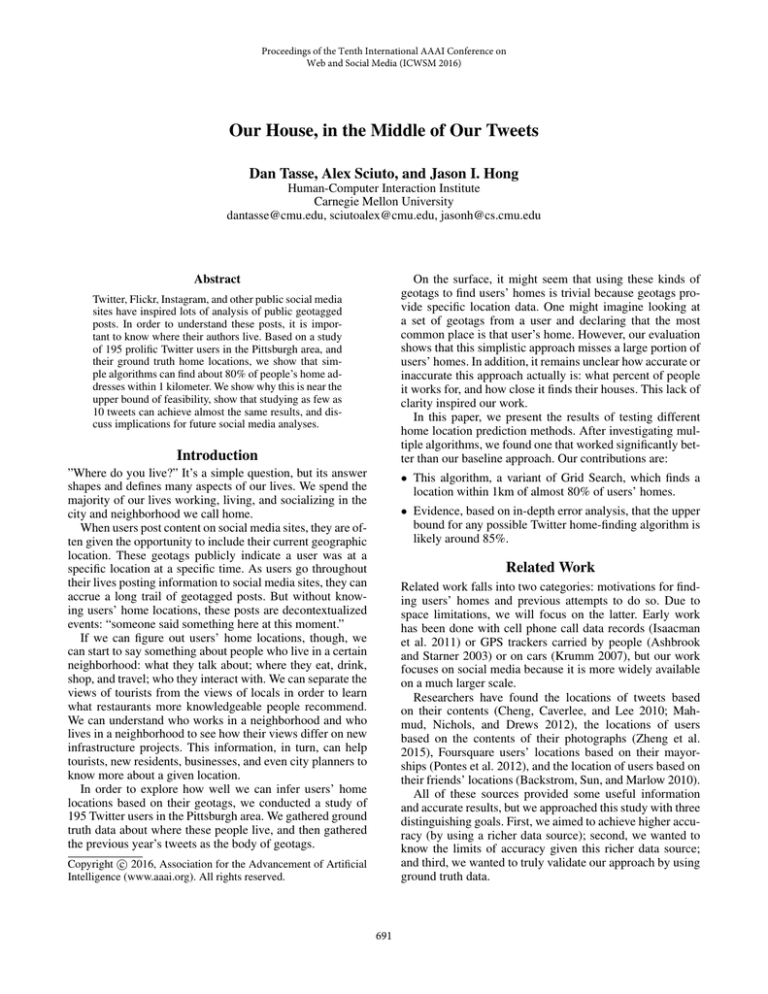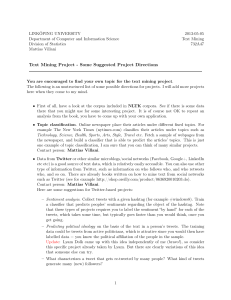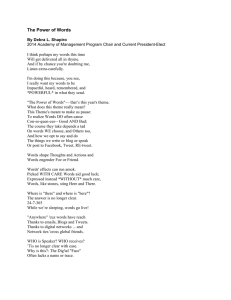
Proceedings of the Tenth International AAAI Conference on
Web and Social Media (ICWSM 2016)
Our House, in the Middle of Our Tweets
Dan Tasse, Alex Sciuto, and Jason I. Hong
Human-Computer Interaction Institute
Carnegie Mellon University
dantasse@cmu.edu, sciutoalex@cmu.edu, jasonh@cs.cmu.edu
On the surface, it might seem that using these kinds of
geotags to find users’ homes is trivial because geotags provide specific location data. One might imagine looking at
a set of geotags from a user and declaring that the most
common place is that user’s home. However, our evaluation
shows that this simplistic approach misses a large portion of
users’ homes. In addition, it remains unclear how accurate or
inaccurate this approach actually is: what percent of people
it works for, and how close it finds their houses. This lack of
clarity inspired our work.
In this paper, we present the results of testing different
home location prediction methods. After investigating multiple algorithms, we found one that worked significantly better than our baseline approach. Our contributions are:
Abstract
Twitter, Flickr, Instagram, and other public social media
sites have inspired lots of analysis of public geotagged
posts. In order to understand these posts, it is important to know where their authors live. Based on a study
of 195 prolific Twitter users in the Pittsburgh area, and
their ground truth home locations, we show that simple algorithms can find about 80% of people’s home addresses within 1 kilometer. We show why this is near the
upper bound of feasibility, show that studying as few as
10 tweets can achieve almost the same results, and discuss implications for future social media analyses.
Introduction
”Where do you live?” It’s a simple question, but its answer
shapes and defines many aspects of our lives. We spend the
majority of our lives working, living, and socializing in the
city and neighborhood we call home.
When users post content on social media sites, they are often given the opportunity to include their current geographic
location. These geotags publicly indicate a user was at a
specific location at a specific time. As users go throughout
their lives posting information to social media sites, they can
accrue a long trail of geotagged posts. But without knowing users’ home locations, these posts are decontextualized
events: “someone said something here at this moment.”
If we can figure out users’ home locations, though, we
can start to say something about people who live in a certain
neighborhood: what they talk about; where they eat, drink,
shop, and travel; who they interact with. We can separate the
views of tourists from the views of locals in order to learn
what restaurants more knowledgeable people recommend.
We can understand who works in a neighborhood and who
lives in a neighborhood to see how their views differ on new
infrastructure projects. This information, in turn, can help
tourists, new residents, businesses, and even city planners to
know more about a given location.
In order to explore how well we can infer users’ home
locations based on their geotags, we conducted a study of
195 Twitter users in the Pittsburgh area. We gathered ground
truth data about where these people live, and then gathered
the previous year’s tweets as the body of geotags.
• This algorithm, a variant of Grid Search, which finds a
location within 1km of almost 80% of users’ homes.
• Evidence, based on in-depth error analysis, that the upper
bound for any possible Twitter home-finding algorithm is
likely around 85%.
Related Work
Related work falls into two categories: motivations for finding users’ homes and previous attempts to do so. Due to
space limitations, we will focus on the latter. Early work
has been done with cell phone call data records (Isaacman
et al. 2011) or GPS trackers carried by people (Ashbrook
and Starner 2003) or on cars (Krumm 2007), but our work
focuses on social media because it is more widely available
on a much larger scale.
Researchers have found the locations of tweets based
on their contents (Cheng, Caverlee, and Lee 2010; Mahmud, Nichols, and Drews 2012), the locations of users
based on the contents of their photographs (Zheng et al.
2015), Foursquare users’ locations based on their mayorships (Pontes et al. 2012), and the location of users based on
their friends’ locations (Backstrom, Sun, and Marlow 2010).
All of these sources provided some useful information
and accurate results, but we approached this study with three
distinguishing goals. First, we aimed to achieve higher accuracy (by using a richer data source); second, we wanted to
know the limits of accuracy given this richer data source;
and third, we wanted to truly validate our approach by using
ground truth data.
c 2016, Association for the Advancement of Artificial
Copyright Intelligence (www.aaai.org). All rights reserved.
691
Data Collection
Baseline (Mode of Geotagged Tweets)
To build a ground truth data set, we began by collecting
3.3 million geotagged tweets via Twitter’s public streaming
API. This API allows a developer to listen for new tweets
that match a geographic parameter in near real time, so we
chose to stream all tweets geotagged within 0.2 degrees latitude and longitude from the center of Pittsburgh. The rectangle we selected had corners at (40.241667, -80.2) and
(40.641667, -79.8), and we collected tweets from January
2014 to January 2015.
Near the end of that year, we used our data set of streamed
geotagged tweets to compile a list of the 4119 most prolific
tweeters for analysis, in order to ensure that our participants
had enough geotagged tweets to analyze. We recruited these
prolific tweeters to take a survey by tweeting a link to them.
Our survey asked seven questions: their age, gender, home
address, length of time they had lived there, work address,
standard commute mode, and any other places they spend a
lot of time. Respondents were paid with a $5 Amazon.com
gift card via email. We received 195 responses.
For each of our 195 users, we used the non-streaming
Twitter API to gather that user’s previous 3,200 tweets (the
maximum number allowed by Twitter). We added any geotagged tweets that occurred outside of Pittsburgh to our data
set. The data collection and survey process were approved
by our university’s Institutional Review Board.
As a trivial baseline, we binned tweets by rounding each
tweet to the nearest 0.01 degree of latitude and longitude,
then predicted that the bin with the most tweets (i.e. the
mode) was the user’s home location.
Last Destination, Weighted Median, Largest
Cluster
Krumm (2007) found people’s homes based on GPS traces
of their cars. We re-implemented three of his methods:
• Last Destination, where we take the median of the latitude
and longitude of all points that are the last coordinate pair
of the day (where a day ends at 3:00 AM)
• Weighted Median, where each point is weighted by the
time until the next point.
• Largest Cluster, using the Scikit-learn implementation of
agglomerative clustering on all tweet locations.
Grid Search
We binned tweets as in the Mode algorithm, but did so recursively, as in (Cheng et al. 2011). First we rounded tweets
to the nearest whole number degree and discarded all tweets
outside the most common bin. We repeated this rounding to
the nearest 0.1 degree, the nearest 0.01 degree, the nearest
0.001 degree, and the nearest 0.0001, predicting the latter as
their home.
Data Set Descriptive Statistics
Our final data set consisted of 146,852 geotagged tweets
from 195 users, who had a median of 533 geotagged
tweets (mean=753, min=15, 1st quartile=271, 3rd quartile=1050, max=3639). These represented a subset of all
of their tweets; the median percent geotagged was 41.1%
(mean=46.2%, min=2.3%, 1st quartile=25.1%, 3rd quartile=61.6%, max=100%).
One notable surprise in our data set was that we had many
young participants (mean=26.9, median=22). This may be
because Twitter is most popular with younger users (Duggan
et al. 2015) or because younger users felt more comfortable
revealing their personal information on our survey. Many of
these young 18-22 year old participants were students who
had multiple “homes”: they lived at their family home (often
outside of Pittsburgh) during the summer and at their campus home (in Pittsburgh) during the school year. Because
the school year lasts 8 months or more, we asked them on
the survey for their campus home, but many of them still
put their family home. As a result, we manually edited 19
students’ “home” addresses to be their campus addresses,
based on inspection of their tweets showing places where
they talked about being “home” near a university.
Multi-level DBSCAN
To cluster points in a more principled way, we used the DBSCAN algorithm (Ester et al. 1996), as implemented in the
scikit-learn library1 , to cluster tweets into clusters of different sizes. We set the Eps parameter (maximum distance between two samples in the same neighborhood) to be 0.2 degrees (latitude/longitude) for “city-level” clusters, 0.005 degrees for “neighborhood-level” clusters, and 0.0005 degrees
for “building-level” clusters 2 .
For each user, we chose the city-level cluster with the
most tweets, then chose the neighborhood-level cluster with
the most tweets, then the building-level cluster with the most
tweets. We guessed that the centroid of the building-level
cluster was the user’s home location.
Grid Search Without Cross-posts
Given the similar accuracy of grid search and DBSCAN, we
returned to grid search with a revised data set. We realized
that 10.4% of our Twitter data set (15,261 of 146,852 tweets)
were cross-posts from social apps. These apps include (in
descending order of frequency) Foursquare/Swarm, Instagram, Untappd, Path, Camera on iOS, Spotify, MLB.com
Methods for Finding Home
In this section, we present a systematic evaluation of several
algorithms for finding users’ homes. In this paper, by “finding users’ homes”, we mean predicting a latitude-longitude
point that is as close as possible to the geocoded address
that they provided. We do not do reverse geocoding to find a
street address.
1
http://scikit-learn.org/
Of course, “distance” does not make sense in terms of degrees
longitude, because the length of a degree of longitude varies based
on the latitude. However, because most of the points we considered
were at a similar latitude, we accepted this inaccuracy in order to
test the method.
2
692
Algorithm
Cross-posts
removed
Mode
Grid Search
Grid Search
Grid Search
Grid Search
Multi-level DBSCAN
Multi-level DBSCAN
Last Destination
Last Destination
Weighted Median
Largest Cluster
Night
only
Median error
553m
57m
54m
51m
49m
75m
75m
350m
520m
400m
362m
% of users
within 100m
1.5
54.4
56.2
56.2
56.9
52.8
52.3
40.5
33.3
40.5
33.8
% of users
within 1km
63.1
73.3
76.8
77.3
79.0
72.3
74.4
66.7
64.1
65.6
69.7
% of users
within 5km
79.0
86.7
88.1
87.6
88.2
87.2
87.2
85.6
82.6
79.0
87.1
Table 1: Results for each algorithm trying to predict each user’s home. Best results are in bold. Results for Weighted Median
and Largest Cluster without cross-posts and daytime posts removed were significantly worse, so we do not present them here.
Last N
Tweets
1
5
10
100
1000
Median
error
245m
84m
62m
65m
51m
% users
w/in 100m
44.6
51.3
58.0
56.0
57.0
% users
w/in 1km
61.7
66.3
75.1
74.6
79.3
% users
w/in 5km
74.1
76.2
81.9
86.0
88.6
100m could be predicted. This may be because of GPS inaccuracy or because people tweet in their neighborhoods but
not at their homes. In our data set, over 10% of people had
zero tweets within 100m of their home, while only 1% had
zero tweets within 1km, so we chose 1km as a reasonable
threshold. Geotagged tweets are currently not a promising
means to find users’ homes at the building level.
Table 2: Results using grid search on the most recent N noncrosspost non-daytime tweets for each user, for various values of N. More tweets allows better prediction, but prediction is remarkably good with as few as 10 tweets.
How many tweets are necessary?
Grid search after removing daytime posts and crossposts was
the most effective method, but it led to another question: if
an application wants to find someone’s home location, how
many tweets does it need? To answer this, we re-ran grid
search on the last N non-daytime non-crosspost tweets per
user, for various values of N. Our results are in Table 2; they
show that, as expected, more tweets allows for a more accurate prediction, but even as few as 10 tweets allows for
remarkably high accuracy.
At the Ballpark, Frontback, Wordpress.com, Klout, LivingSocial, Sportacular, and MySpace. In each of these social
apps, tweeting was a byproduct of another action (as opposed to Twitter clients such as Tweetdeck and Tweetcaster).
Furthermore, most of these are intended to be used outside
the home. Therefore, they cannot help (and indeed would
hurt) any home-finding algorithm. We removed them from
the data set and performed grid search and DBSCAN again.
We then reasoned that nighttime tweets (from 8:00PM to
6:00AM) would be more predictive of home location than
daytime tweets, so we removed daytime tweets and ran our
algorithms again. This removed 77,122 of our tweets, leaving us with 54,469 tweets. We found the highest accuracy
removing both of these data sets.
Error Analysis and Discussion
We have shown that it is not hard, but not trivial, to find
most geotagging Twitter users’ home neighborhoods based
on their geotagged tweets. We found multiple common reasons that we could not find more users’ exact homes.
People Moving Residences Forty-nine people in our data
set (25.1%) had moved within the last 6 months, and we
were unable to accurately locate 19 of them, mostly because
they had not yet tweeted very much at their new house. In
the United States overall, 11.6% of all people moved within
the last year. Assuming that this distribution is roughly uniform, then about half that many, or 5.8%, moved within the
last six months. Therefore, our sample has over four times
as many recent movers as the average in the United States.
Taking into account our users’ younger age does not solve
this problem: only 23.1% of 20-24-year-olds have moved in
the last year (U.S. Census Bureau 2015), so we would expect
11.5% of young people to have moved in the last 6 months,
not 25.1%.
It may seem natural to propose that a solution to recent
movers is to build a model that uses only the most recent
Finding Home Results
For each algorithm, we computed the distance from the
user’s true home to the algorithm’s prediction of home. We
computed median prediction error across all users, as well
as the percent of users with prediction error less than 100
meters, 1 km, and 5km. Results are in Table 1.
By all metrics, grid search after removing cross-posts and
daytime posts was the most successful. We can predict almost 80% of people’s homes within 1km, localizing them at
about the neighborhood level.
Locating people at the building level is a bit more difficult; just over half of people’s exact home location within
693
shown a simple but effective way to find about 80% of users’
tweets within 1km of their homes, by using grid search after removing daytime posts and cross-posts. We have also
shown, through a detailed error analysis, that a reasonable
upper bound would be about 84%. We hope that this helps
developers to better make use of this rich source of data.
tweets. However, in our sample, about half of all users had
not posted a geotagged tweet in the month before the survey,
so recency-based approaches would exclude too many users.
Twitter Account Lifespan Since we began collecting
data, 4 of our 195 participants (2.1%) closed their accounts
or protected their tweets. As a result, we were not able to
search for any of their newer tweets; we could only rely on
the tweets we had collected already via the streaming API.
Acknowledgements
This research was funded in part by the HCII Foundation.
Frequent Travelers and Students Three people in our
data set are frequent cross-country travelers. They had multiple homes or constantly moved between cities. Because of
their frequent movement, they had roughly equal tweets in a
variety of cities. For them, “home” itself was ill-defined.
In addition, the problem we mentioned before about students affected our accuracy here as well. We manually corrected 19 students who incorrectly listed their family’s home
as their home, so that we accurately predicted their campus
home. However, for four students, we predicted their family’s home instead of their campus home. Students are a special population who often move frequently between multiple
homes, so finding their “real” home will always be difficult.
References
Ashbrook, D., and Starner, T. 2003. Using gps to learn
significant locations and predict movement across multiple
users. Personal and Ubiquitous Computing 7(5):275–286.
Backstrom, L.; Sun, E.; and Marlow, C. 2010. Find me
if you can: improving geographical prediction with social
and spatial proximity. Proceedings of the 19th international
conference on World wide web 61–70.
Cheng, Z.; Caverlee, J.; Lee, K.; and Sui, D. 2011. Exploring Millions of Footprints in Location Sharing Services.
Proceedings of ICWSM.
Cheng, Z.; Caverlee, J.; and Lee, K. 2010. You Are Where
You Tweet: A Content-Based Approach to Geo-locating
Twitter Users. Proc. of the 19th ACM International Conference on Information and Knowledge Management 759–768.
Duggan, M.; Ellison, N. B.; Lampe, C.; Lenhart, A.; and
Madden, M. 2015. Social media update 2014. Pew Research
Center (January):18.
Ester, M.; Kriegel, H.-P.; Sander, J.; and Xu, X. 1996. A
Density-Based Algorithm for Discovering Clusters in Large
Spatial Databases with Noise. In KDD, volume 2, 635–654.
Isaacman, S.; Becker, R.; Cáceres, R.; Kobourov, S.;
Martonosi, M.; Rowland, J.; and Varshavsky, A. 2011. Identifying important places in peoples lives from cellular network data. In Pervasive computing. Springer. 133–151.
Krumm, J. 2007. Inference Attacks on Location Tracks.
Pervasive Computing 10(Pervasive):127–143.
Mahmud, J.; Nichols, J.; and Drews, C. 2012. Where Is This
Tweet From? Inferring Home Locations of Twitter Users. In
ICWSM, 511–514.
Pontes, T.; Vasconcelos, M.; Almeida, J.; Kumaraguru, P.;
and Almeida, V. 2012. We Know Where You Live: Privacy
Characterization of Foursquare Behavior. Proceedings of
the ACM Conference on Ubiquitous Computing 898.
Qu, Y., and Zhang, J. 2013. Regularly visited patches in
human mobility. In Proceedings of the SIGCHI Conference
on Human Factors in Computing Systems, CHI ’13, 395–
398. New York, NY, USA: ACM.
U.S. Census Bureau. 2015. Current population survey data
on migration/geographic mobility. http://www.census.gov/
hhes/migration/data/cps.html.
Zheng, D.; Hu, T.; You, Q.; Kautz, H.; and Luo, J. 2015.
Towards lifestyle understanding: Predicting home and vacation locations from user’s online photo collections. In AAAI
International Conference on Web and Social Media.
Best Case Scenario Removing these 30 people (19 recent
movers, 4 closed accounts, 3 frequent travelers, and 4 students) leaves a “best case” scenario where we should be
able to predict 165 users’ home locations. This means our
estimated upper limit of correct prediction is 84.6%.
Difficulty of defining a home location
Comparing the results of our survey with our estimated
home locations has revealed a discrepancy between what
people consider home and what they write when asked to
list their home address. When trying to locate people in
the future, one might try to categorize people as having
one home, having multiple homes, or having no particular home. More deeply, though, the students and frequent
movers in our data set call into question the usefulness of
our goal of defining a “home” location at all. These cases
suggest an alternative goal of defining a number of locations
that are important to individuals, or of defining how “homely” a tweet cluster is. A number of other researchers have
attempted this using different sets of data (Krumm 2007;
Qu and Zhang 2013); this may be a more fruitful approach.
Generalizability of Home-Finding Results
The simplicity of our algorithm (grid search after removing
cross posts and daytime posts) is beneficial in two ways: it
is easy to re-implement, and it avoids concerns of overfitting. Overfitting is another reason we chose not to pursue a
more complex machine learning-based algorithm. If we had
proposed a more complex solution, it may only work on our
limited set of tweets around Pittsburgh, but we feel confident
that our algorithm should perform well on other Twitter data
sets (and may even generalize to other social media).
Conclusion
Finding a user’s home is an important first step in order to
accurately make sense of their geotagged tweets. We have
694







